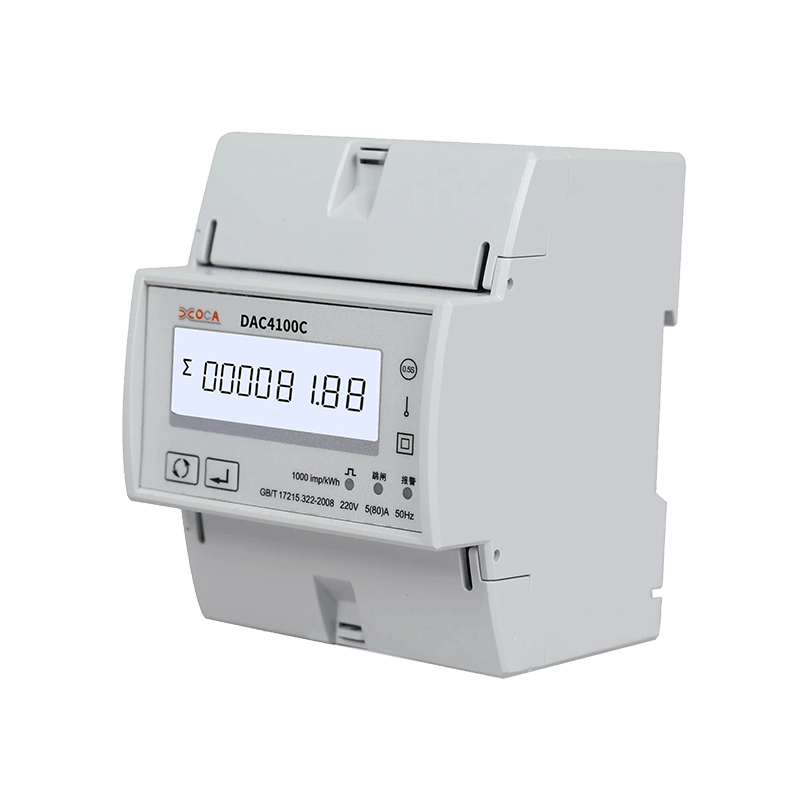What Is a DIN Rail Power Meter and How Does It Work?
A DIN Rail Power Meter is a specialized device designed to monitor electrical parameters in industrial, commercial, and residential settings. Mounted on a standard DIN rail, these meters provide accurate measurements of voltage, current, power consumption, and other critical electrical data. They are widely used in energy management systems to optimize power usage and reduce costs.
DAC4100C One Phase 2 Wires DIN Rail Modbus Smart Energy Meter with Relay
Key Components of a DIN Rail Power Meter
The primary components of a DIN Rail Power Meter include:
- Current Transformers (CTs): These sensors measure the current flowing through a conductor without direct electrical contact.
- Voltage Sensors: These components monitor the voltage levels in the electrical circuit.
- Processing Unit: This unit calculates power consumption, harmonics, and other derived parameters.
- Display/Communication Module: Provides real-time data visualization or transmits data to external systems.
Working Principle
The meter operates by continuously sampling voltage and current signals. The processing unit then computes active power, reactive power, power factor, and energy consumption. Advanced models can also analyze harmonic distortion and phase imbalances.
Benefits of Using a DIN Rail Mounted Energy Meter in Industrial Applications
Industrial facilities require robust and reliable energy monitoring solutions. A DIN Rail Mounted Energy Meter offers several advantages in such environments:
Space Efficiency
DIN rail mounting allows for compact installation alongside other electrical components in control panels. This saves valuable space in crowded industrial settings.
Enhanced Energy Management
These meters enable:
- Real-time monitoring of energy consumption patterns
- Identification of energy-intensive equipment
- Detection of power quality issues
Cost Savings
By providing detailed energy usage data, these meters help facilities:
- Reduce peak demand charges
- Optimize equipment scheduling
- Identify potential energy savings
How to Choose the Best Single Phase DIN Rail Energy Meter for Your Needs
Selecting the right Single Phase DIN Rail Energy Meter requires careful consideration of several factors:
Key Selection Criteria
When evaluating single phase meters, consider:
- Accuracy Class: Typically ranges from Class 0.2S to Class 2
- Measurement Parameters: Basic models measure kWh, while advanced units track power quality indicators
- Communication Options: Modbus, M-Bus, or wireless protocols
Comparison of Single Phase Meter Features
The table below compares typical features across different meter classes:
| Feature | Basic Meter | Intermediate Meter | Advanced Meter |
|---|---|---|---|
| Accuracy | Class 2 | Class 1 | Class 0.5S |
| Parameters Measured | kWh only | kWh, voltage, current | All parameters plus harmonics |
| Communication | None | Modbus RTU | Modbus TCP, wireless |
Installation Guide for Three Phase DIN Rail Power Monitor Systems
Proper installation of a Three Phase DIN Rail Power Monitor is crucial for accurate measurements and system safety.
Pre-Installation Considerations
Before installation:
- Verify the meter's voltage and current ratings match the electrical system
- Ensure proper clearance around the meter for heat dissipation
- Confirm the DIN rail has sufficient space and proper mounting
Step-by-Step Installation Process
- De-energize the electrical panel and verify absence of voltage
- Mount the meter on the DIN rail, ensuring secure engagement
- Connect voltage inputs following the wiring diagram
- Install current transformers if not using direct measurement
- Configure communication settings if applicable
Understanding Smart DIN Rail Electricity Meter Technology
Smart DIN Rail Electricity Meter represents the next generation of energy monitoring solutions with advanced capabilities.
Key Features of Smart Meters
Modern smart meters offer:
- Two-way communication for remote data collection
- Real-time energy consumption tracking
- Advanced power quality analysis
- Integration with energy management systems
Benefits Over Traditional Meters
Compared to conventional meters, smart versions provide:
- Higher measurement accuracy
- More detailed energy consumption data
- Better diagnostic capabilities
- Remote configuration options
Comparing Wireless DIN Rail Energy Monitor with Wired Solutions
The choice between Wireless DIN Rail Energy Monitor and traditional wired meters depends on application requirements.
Advantages of Wireless Solutions
Wireless monitors offer:
- Simplified installation with no communication wiring
- Flexibility in meter placement
- Easier system expansion
Considerations for Wired Systems
Wired connections may be preferable when:
- High reliability is critical
- Electrical noise is present
- Long-distance communication is needed
Comparison Table
| Feature | Wireless | Wired |
|---|---|---|
| Installation Complexity | Low | Moderate |
| Communication Reliability | Subject to interference | Highly reliable |
| System Expandability | Easy | Requires additional wiring |


 English
English 中文简体
中文简体







